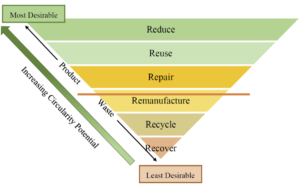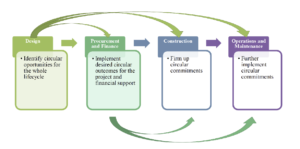
Promoting Circular Economy in Public-Private Partnership for the SDGs
it is consequently of utmost importance for the international community to accelerate sustainable development initiatives because the current pace of global progress is still insufficient to achieve SDG targets by 2030. The two recent events, i.e., the UN Climate Change Conference (COP27) concluded on 20 November in Sharm el-Sheikh, Egypt, and the sixth session of the UNECE Working Party on Public-Private Partnerships on 1-2 December 2022 in Geneva were two significant endeavors in building a sustainable and resilient future. The COP27’s decision to establish and operationalize a fund to compensate vulnerable nations for ‘loss and damage’ from climate-induced disasters was called “an important step towards justice” by the UN Secretary-General. The call for “a giant leap on climate ambition” stressing the need to “drastically reduce emissions now” emphasizes the need for circular economy (CE).

Figure: Circular economy hierarchy (source ECE, based on the 6Rs of sustainability)
As an important step toward achieving circular economy, the global community should investigate how the Public-Private Partnership approach can boost SDG investment and accelerate the development of sustainable infrastructure – green, resilient, inclusive, circular, fiscally sustainable and of high quality – for economic recovery and reconstruction. As an endeavor in this direction, the Economic Cooperation and Trade Division (ECTD) prepared the Guidelines on Promoting Circular Economy in Public-Private Partnerships for the United Nations Sustainable Development Goals. The Guideline tries to answer the following key questions:
- How is the PPP approach contributing to enable sustainable infrastructure projects?
- How can digital and green transformations for sustainable development, including green PPP procurement and circular economy transition, be achieved in countries through PPPs for the SDGs? and
- How could sustainable finance be further mainstreamed into the ECE PPP work to address the ever-increasing infrastructure investment gap?
The Guideline has three main sections. Section I provides details and introduces the concept of CE, the PPPs for the SDGs approach, and their interactions. Section II presents multiple examples and opportunities for the application of CE practices in PPPs for the SDGs projects whilst building the case for government action to further promote and encourage SDG-compliant industry practices. Finally, section III suggests a set of policy options to boost CE.
Studies show that the PPP approach provide significant opportunities for CE. As the SDG framework already reflects a large number of CE objectives and UNECE’s “PPPs for the SDGs” approach is modelled upon the SDGs framework, there is a large overlap between this PPP approach and the CE. Indeed, CE objectives are embedded within and across the PPPs for the SDGs approach in various ways. For example, “Access and Equity” as an outcome of the PPP approach is linked to the CE principles of “Replacement of the ‘end-of-life’ concept with a regenerative and restorative design” and “achieving sustainability goals and reducing environmental impact”. Or, “Stakeholder Engagement” as another outcome of the PPP approach is linked to the CE principles of “Ensures that the core principles are respected by engaging with stakeholders concerned about achieving the CE agenda”. Therefore, it is important to promote the circular economy practices during the PPP lifecycle, including the design, procurement and Finance, construction, and operation and maintenance.

Figure: Flow of circular economy practices during the PPP process (source: ECE)
During the design stage, the main strategies to mitigate environmental impacts of a project are considered and planned out by designers. Therefore, it is the best time governments can efficiently embed CE principles and practice into the design. For instance, they can use design approaches that reduces the use of raw materials. In addition, they can design for disassembly, that is a powerful approach to incorporate CE principles in project delivery by supporting the possible reuse of materials and components in future stages of the PPP process. Last but not least, designers can benefit from a full lifecycle approach to promote CE practices throughout the whole life of a PPP project.
During the procurement and finance stage, governments can use circular procurement regime, by tendering for and purchasing works, goods or services that are part of closed energy and material loops within supply chains, and mitigating or avoiding, negative environmental impacts and waste creation. In addition, they can implement CE strategies in their bidding process, by for example, demanding the submission of tender containing circular aspects, including technical specifications that seek circular targets, or using award criteria that put special weight on the targets of CE approaches. Finally, governments can focus on financing circular PPPs, by for example, green finance that prioritizes investments in companies or projects that are deemed environmentally responsible.
During the construction stage which according to the EU Circular Economy Action Plan is responsible for over 35 percent of the EU’s total waste generation, governments should rethink about changing traditional standards for construction materials and methods with the aim to minimize the use of virgin resources, as well as outdated specifications about construction solid, liquid, and gasification wastes.
During the operation and maintenance stage, CE opportunities can be found within daily maintenance and system renewals of the infrastructure asset, as well as waste generation and energy consumption from its daily operations, amongst other things. PPP performance requirements and operational regulations should be designed such that they incentivize operational efficiency and promote system longevity and holistic maintenance strategies and thus help governments to achieve desired CE outcomes. In addition, to properly manage O&M waste generation, governments should develop relevant frameworks that help PPPs integrate CE approaches during O&M, including the treatment of recyclable liquid or solid waste that is generated from an asset, preferably repurposing it at a local level, rather than disposing of it entirely.
The Guideline also provides a comprehensive list of policy options for national and municipal governments, their finance and procurement authorities, and sector implementation agencies. The recommended policy options may assist developing policies and adopting procedures that encourage projects to adopt CE practice through a PPPs for the SDGs approach. The interested reader may refer to the guideline for further study of the policy options and examples. While these guidelines provide a useful roadmap for boosting circular economy in different countries with different local and national socio-economic, environmental and political contexts, they do not prescribe a “one-size-fits-all” approach.
